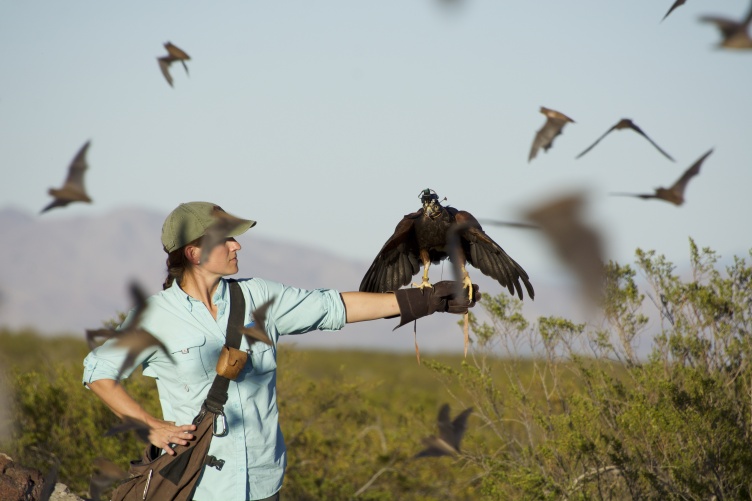
Laura Kloepper and her winged research assistant collect data on bat movement.
Hawks that hunt swarming bats steer toward a fixed point in the swarm rather than targeting individual bats, reports a study co-authored by UNH researcher Laura Kloepper and recently published in Nature Communications. The findings aid our understanding of how predators select and track a target among thousands of potential prey.
It is generally thought that being in a large group — such as a swarm of bats, flock of birds or school of fish — provides protection from predators due in part to the ‘predator confusion effect’: the idea that large numbers of potential targets will confuse predators, making it more difficult for them to focus on and capture a specific individual. If predators get confused, their success rate in capturing prey should decrease as the number of available prey increases. However, empirical evidence for the confusion effect has been mixed.
"Across the animal kingdom, we find that animals are constantly evolving adaptations and counter-adaptations to get one step ahead of each other. Bats likely evolved this dense grouping to try to confuse predators, but hawks have evolved a strategy to avoid this confusion."
Kloepper, who is a visiting assistant professor in the department of biological sciences, along with Caroline Brighton from the University of Oxford, the study’s lead author, and other colleagues observed Swainson’s Hawks (Buteo swainsoni) and other raptors hunting a colony of approximately 700,000 to 900,000 Mexican free-tailed bats (Tadarida brasiliensis) as they migrated from Mexico to Central America — a migration thought to be the largest mammalian migration on the planet. By using an array of cameras, the researchers were able to reconstruct the 3D flight trajectories of the raptors and bats.
While the research sheds light on why bats form dense aggregations and have remarkably coordinated movement when they emerge from caves and whether the predation risk from hawks drives their grouping behavior, the researchers’ analyses revealed that the hawks had developed a solution to the challenge of capturing specific prey in a dense swarm: instead of targeting an individual bat, they would target a fixed point within the throng. A bat on a collision course would appear to the raptor to be on a constant bearing, singling it out for snatching.
The behavioral modification puts them a step ahead in what Kloepper refers to as the predator-prey evolutionary arms race.
“Across the animal kingdom, we find that animals are constantly evolving adaptations and counter-adaptations to get one step ahead of each other,” she says. “Bats likely evolved this dense grouping to try to confuse predators, but hawks have evolved a strategy to avoid this confusion: instead of trying to target individual bats, they instead target the center of the dense group, extend their talons, and hope that the odds are in their favor.”
Kloepper recently joined COLSA’s faculty and has a joint appointment in UNH’s Center for Acoustics Research and Education where she leads the Ecological Acoustics and Behavior Lab. Her work examines the sensorimotor behavior — how bats are sensing and moving — in their natural environment.
“Specifically, I focus on bats that form large groups in caves,” she says. “When these bats emerge from their cave to feed each evening, they form tight groups that appear as a dark river in the sky. The results from this paper help us understand some of the drivers as to why bats form these groups.”
Now that the team has discovered how hawks have adapted to counter bat grouping behavior, the next step is to understand adaptations bats have for being in groups. To that end, the researchers recently returned from fieldwork where they collected data on bat movement using a trained hawk fitted with a custom camera and microphone as it flew through the bat swarm. Kloepper’s lab will be analyzing the data this fall looking for adaptive sensorimotor strategies bats use in these groups.
-
Written By:
Sarah Schaier | College of Life Sciences and Agriculture

















































